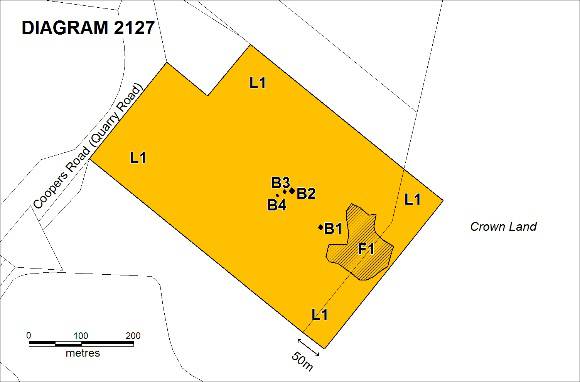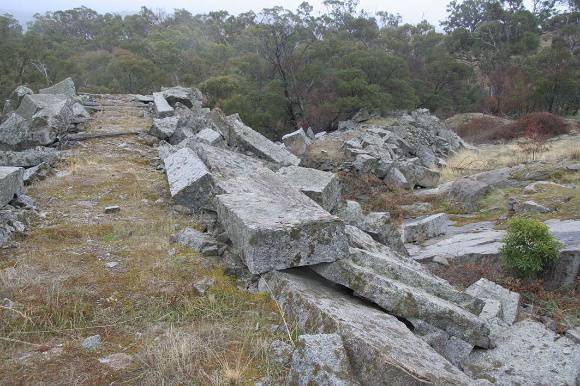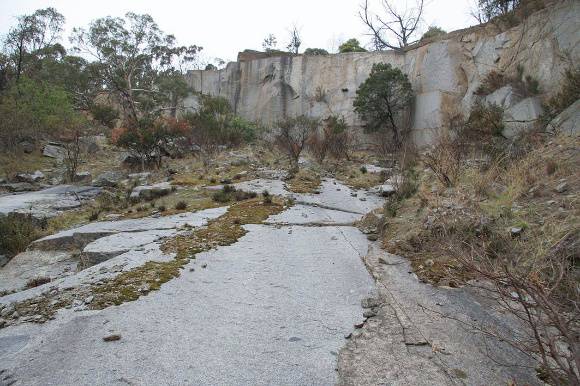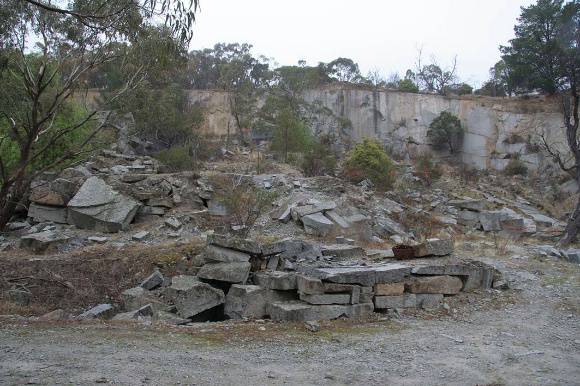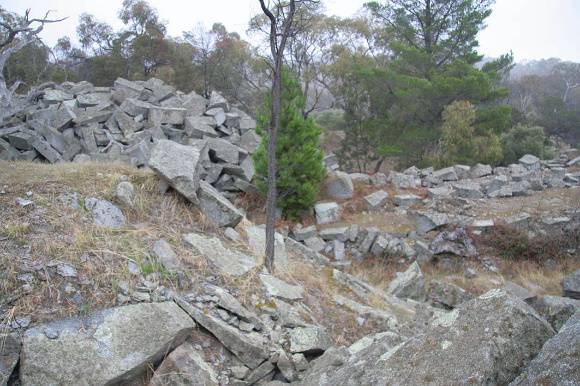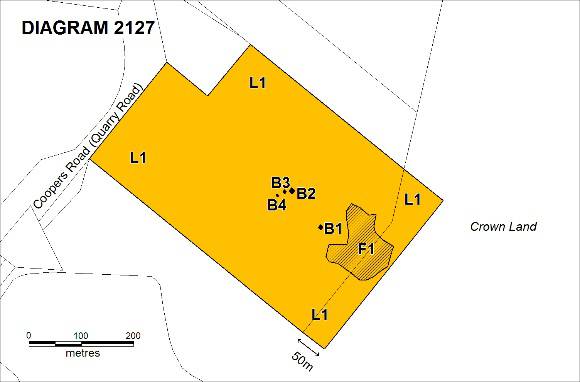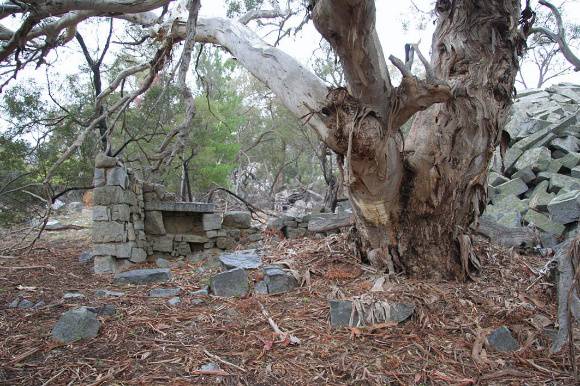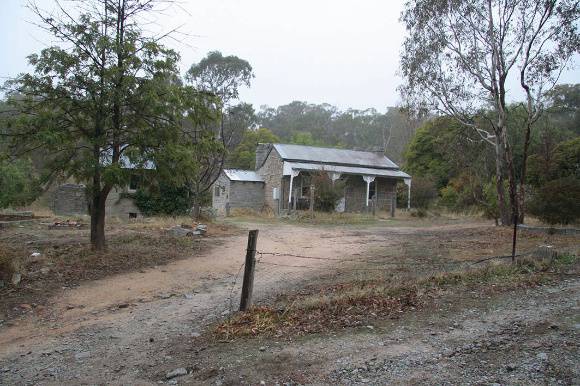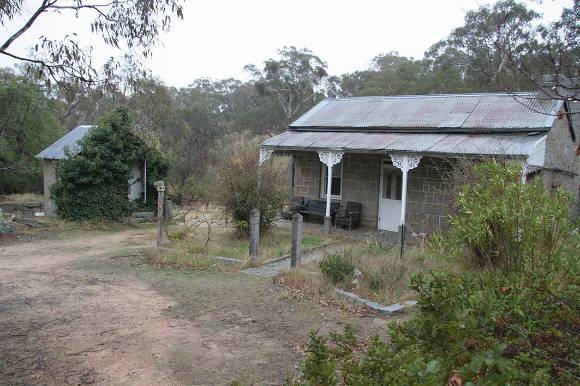| Back to search results » | Back to search page » |
|
BLIGHTS QUARRY
Statement of Significance
What is significant Blight's Quarry, opened in 1862 and located on the north-east lower
slopes of Mt Alexander, consists of an eight metre high and 90 metres
wide upper quarry face with sloping excavation and side walls
extending for approximately 100 metres below. A layered succession of
linear spoil heaps of granite blocks indicates the use of tramways to
transport waste away from the quarrying area. Waste granite was also
used to construct substantial mounting platforms for the Scotch
derrick cranes which were used extensively within the quarry. A
corrugated iron clad timber shed contains machinery mountings, and
nearby are mounts for a compressed air tank. The ruins of a small
building with fireplace below the earliest waste piles may indicate an
early residence. Just below on the approach road is a small granite
cottage and associated small two-storied building which probably date
from the 1860s or 70s. A small early twentieth century timber bungalow
is located nearby. The buildings are surrounded by remnant garden with
orchard and ornamental planting. Fireplaces from small dwellings which
may have accommodated quarrymen are located high on the southern
corner of the site. Large scale quarrying of granite in the Mt Alexander - Ravenswood
area started in 1859 with stone supplied to the Melbourne to Echuca
Railway. Cornish quarryman Joseph Blight arrived in the colony in
1855, and achieved some success in quartz reef mining at Eureka Reef
in the Chewton/Campbells Creek area. He then turned to quarrying at
Mount Alexander, at first providing stone for the railway. He began to
work the Blight's Quarry site in 1862. The location on the lower
slopes of the mountain made for easy transport of stone and waste.
There was also a fortuitous alignment of bedding, joints and 'freeway'
which allowed dimension stone to be extracted with ease. On the other
hand, the presence of flaws including xenoliths ('black spot'), meant
that there was considerable wastage of stone, reflected in the
extensive waste heaps on the site. Blight and his wife moved to
Castlemaine around 1890, leaving management to another Cornishman,
John Jennings. Blight died in 1897 but the business continued under
the name J. Blight and Co. The peak of output in the 1910s has been
attributed to the increasing popularity of the stone for monumental
work in cemeteries. In this period there were seven cranes operating
and sixteen men in regular employment. Despite the high demand, no
other large quarry was established on the mount until the Harcourt
Granite quarry was opened in the 1920s. Tingay and Oliver's quarry
followed in the early1940s, along with a number of other smaller
quarries. Use of stone in major buildings declined in the 1950s, but
quarry was kept alive by the monumental trade. Blights quarry closed
in 1964, with increasing competition from other quarries run by
monumental masons who processed the stone on site. At first Harcourt stone was used locally, but from the late 1880s it
was used extensively on prestigious buildings in the centre of
Melbourne. Buildings and monuments which used stone from Blight's
Quarry include the Burke and Wills Memorial in the Melbourne General
Cemetery (1864), the Princes Bridge (1888), Block Arcade (1892),
Equitable Building Collins Street (1896, demolished, stones now
displayed in front of the Exhibition Building), Burns Memorial (1903,
originally St. Kilda Road, now Treasury Gardens), Flinders Street
Station (1910), Former National Bank of Australasia Head Office
Collins Street (1927). From the 1880s, stone from Blight's Quarry was
exported to New Zealand and Europe. The quarry received a gold medal
in the Franco-British Exhibition in London in 1908. How is it significant Blight's Quarry is of historical significance to the State of Victoria. Why is it significant Blight's Quarry is of historical significance for its capacity to
represent the quarrying of Harcourt granite, a high quality stone
which was used in the local area from the late 1850s and was used
extensively on major buildings and monuments in Melbourne from the
1880s. The stone was also used extensively for monumental work in
cemeteries around Australia and was exported in quantity to Europe and
New Zealand. Blight's Quarry is of historical significance for its association
with the gold rush in Victoria and as an example of how gold rush
immigrants turned to their former trades as the gold ran out. Blight's Quarry is of historical significance as the only large
quarry working on Mount Alexander from 1862 up until the 1920s and as
the quarry which best represents nineteenth century quarrying of this stone. Blight's Quarry is of historical significance for its potential to
reveal information about technology and work practices of granite
quarrying from the 1860s up to the mid-twentieth century. The site
also has the potential to be used to educate on the technology and
work practices of granite quarrying over that period. The site has
features which dramatically illustrate the processes of production of
dimension stone, including extraction from the quarry face, cutting to
size and movement of stone and which demonstrate the manual nature of
the work in the nineteenth and early twentieth century.
Group
Mining and Mineral Processing
Category
Quarry


